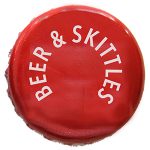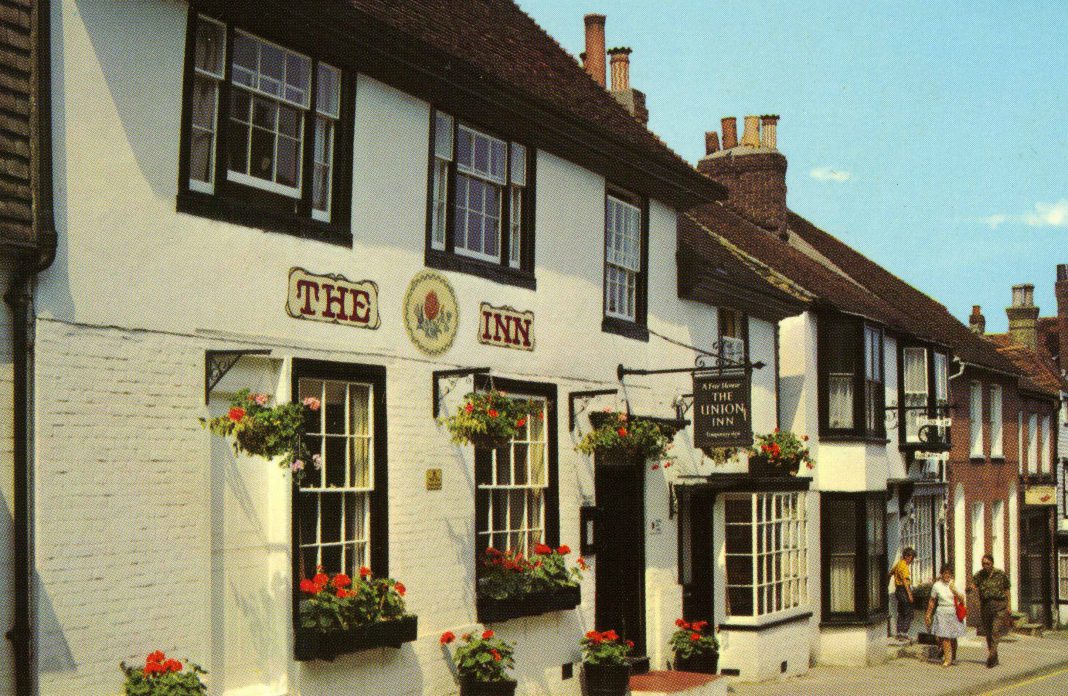The Union Inn joined the ranks of the Lost Pubs of Rye when it closed in 2012. It was originally two 16th century cottages and a small shop. By 1830 it had become the Union Beer House with a shop attached, both occupied by John Hunter. For some years he worked as a tailor in the shop while his wife Sarah ran the pub.
In 1841 the pub was sold and the deeds tell us that it was “sometime since converted into a public house bearing the sign of the Union Inn”. A valuation of the property in 1861 shows the licence was then held by their son James and thus, for 30 years was run by the Hunter family. The valuation describes the Union as a very small house, with only one public room partitioned into a bar and a bar parlour. It had a kitchen and wash house at the rear of the building. At some later date the pub was enlarged when the beer house and the shop were integrated.
The valuation tells us that the bar parlour had tables and benches screwed to the floor, shelving behind the bar and a zinc blind on two brass rods. Among the bar equipment was a “spirit fountain”, as well as some ceramic spirit barrels with brass taps and fittings, and also a beer engine. Beer was pulled in the bar and parlour customers were served through a serving hatch in the partition. The shop was basic with only a counter and shelving although the valuation points out with some pride, that “the pub sign was made of wrought iron, and was the first-class work of a local blacksmith”.
By the late 1860s the Union was popular with fishermen and boat owners. Their patronage was reflected in the fact that a number of coroner’s inquests into accidents and deaths in the fishing industry were held here. Fishermen who might be required to attend these inquests would be more comfortable in the Union than in pubs of a higher social class such as the Red Lion or the George.
A typical inquest into the drowning of a fisherman in Rye Harbour was held in the Union in 1881 but failed to come to any conclusion as to how the “accident” had happened. They could only agree that the deceased was “found drowned in Rye Harbour”.
In the 1990s the Union Inn became Rye’s most haunted pub boasting three ghosts. One was the ghost of a young unmarried mother who died after being pushed down the cellar steps in the 1850s. In 1993 researchers into spiritual phenomena witnessed banging and laser flashes and also the kitchen door opening and closing by itself.
Further investigations revealed a second ghost when the landlord’s young son was visited by “Postman Pat” at night. Several guests experienced the ghost of a seaman in a blue jacket and a sou’wester. The old lady next door also experienced the seaman in her attic. Was this the ghost of an old smuggler moving contraband between the attics, or was it perhaps the fisherman who drowned in 1881?
Downstairs, the ghost of Emily, a young woman in a red dress, was often seen walking through the bar towards the cellar steps. She apparently died from a broken neck after being pushed down the steps when pregnant. According to the Ghost Club investigators, Emily and her family lived there in 1856, and her father, a local mortician, was apparently ashamed of her pregnancy. When the investigators made contact with the ghost of Emily in 1992, she denied the baby was hers. The baby’s remains are allegedly contained behind a glass brick in the rear dining room. The pub was reputedly rid of its ghosts in 1993 when exorcists rebalanced the pub’s hidden ley-lines with a row of nine crystals.
The Pubs of Rye, 1750-1950 by David Russell is available from The Rye Bookshop, 25 High Street, the Rye Heritage Centre, Strand Quay; Adams, 9 High Street; The Queen Adelaide, 23 Ferry Road or online. Other books by David Russell are The Pubs of Hastings & St Leonards, The Pubs of Lewes, The Swan, Hastings and Register of Licensees for Hastings & St Leonards.
Photo: John Hodges



